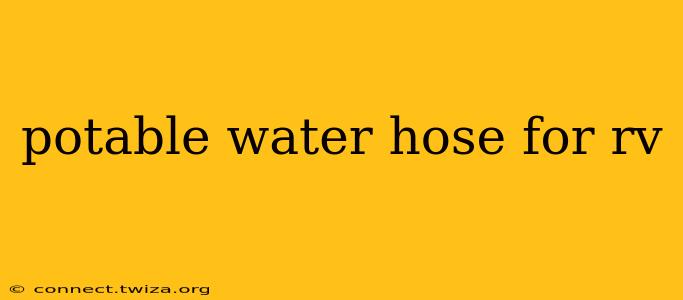Finding the perfect potable water hose for your RV can feel overwhelming with so many options available. This comprehensive guide will help you navigate the choices, ensuring you select a hose that's safe, durable, and provides years of reliable service. We'll cover everything from materials to features, helping you make an informed decision for your next RV adventure.
What is a Potable Water Hose?
A potable water hose is specifically designed to carry drinking water. Unlike standard garden hoses, potable water hoses are made from materials that won't leach harmful chemicals into your water supply, ensuring your drinking water remains safe and clean. This is crucial for maintaining good health during your RV travels.
What Makes a Potable Water Hose Different from a Garden Hose?
The key difference lies in the materials used. Garden hoses often contain materials that are not suitable for drinking water, potentially contaminating it with chemicals. Potable water hoses, on the other hand, are constructed from non-toxic materials like food-grade PVC or reinforced polyethylene, ensuring the safety of your drinking water. They also often feature a thicker wall construction for better durability and resistance to kinking.
What Materials are Potable Water Hoses Made Of?
Several materials are commonly used in the construction of potable water hoses:
- Food-Grade PVC: A popular choice due to its affordability and durability. Look for hoses explicitly labeled as "food-grade" or "NSF-certified" to ensure safety.
- Reinforced Polyethylene: Offers superior durability and resistance to kinking compared to PVC, but is typically more expensive.
- EPDM Rubber: Known for its excellent flexibility and resistance to UV degradation, making it ideal for prolonged outdoor use. However, it tends to be the most expensive option.
How long should my RV potable water hose be?
The ideal length of your potable water hose depends on the distance between your RV and the water source. It's recommended to have a hose that's long enough to reach comfortably without excessive stretching or kinking. Consider purchasing a hose that is slightly longer than you anticipate needing, allowing for flexibility in different camping situations. Many RVers opt for multiple shorter hoses that can be connected together as needed.
What is the best type of fitting for my RV potable water hose?
RV potable water hoses typically come with either threaded or quick-connect fittings. Threaded fittings offer a secure connection, while quick-connect fittings allow for fast and easy attachment and detachment. The choice depends largely on personal preference and your RV's water system setup. It’s important to ensure your chosen hose fittings are compatible with your RV's connections.
How do I maintain my RV potable water hose?
Proper maintenance ensures the longevity of your potable water hose. After each use, thoroughly rinse the hose with clean water to flush out any remaining water and prevent the growth of bacteria or algae. Store the hose in a clean, dry place, away from direct sunlight and extreme temperatures. Regularly inspect the hose for any signs of damage or wear and tear; replace it immediately if you notice any cracks or leaks.
How often should I replace my RV potable water hose?
The lifespan of a potable water hose depends on several factors, including the frequency of use, storage conditions, and the material it's made of. However, as a general rule, it’s best to replace your potable water hose every 2-3 years or sooner if you notice any signs of deterioration. Regular inspection is key to ensuring the safety and reliability of your water supply.
By carefully considering these factors and selecting a high-quality potable water hose, you'll ensure a safe and reliable water supply for your RV adventures for years to come. Remember, your health depends on it!
